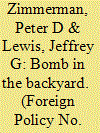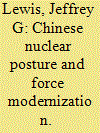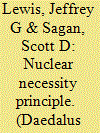| Srl | Item |
| 1 |
ID:
074620


|
|
|
| 2 |
ID:
089070


|
|
|
|
|
| Publication |
2009.
|
| Summary/Abstract |
Claims that China is the only nuclear power currently expanding its arsenal fail to take into account the technical, historical, and bureaucratic realities that shaped China's nuclear posture and drive its ongoing modernization. China's strategic modernization is largely a process of deploying new delivery systems, not designing new nuclear warheads; the majority of its new missiles are conventionally armed. Today, China maintains the smallest operationally deployed nuclear force of any of the legally recognized nuclear weapon states, operates under a no-first-use pledge, and keeps its warheads off alert. The modernization of China's delivery systems is the culmination of a decades-long plan to acquire the same capabilities deployed by the other nuclear powers. U.S. concerns about this modernization focus too much on deterring a deliberate Chinese attack and ignore the risk that modernized U.S. and Chinese forces could interact in unexpected ways during a crisis, creating uncontrollable escalatory pressures. To manage this risk, Washington should assure Chinese leaders that it does not seek to deny China's deterrent, in exchange for some understanding that China will not seek numerical parity with U.S. nuclear forces.
|
|
|
|
|
|
|
|
|
|
|
|
|
|
|
|
| 3 |
ID:
147557


|
|
|
|
|
| Summary/Abstract |
In 2013, Obama administration spokesmen stated that all U.S. nuclear war plans “apply the principles of distinction and proportionality and seek to minimize collateral damage to civilian populations and civilian objects.” We analyze U.S. nuclear policy documents and argue that major changes must be made if U.S. nuclear war plans are to conform to these principles of just war doctrine and the law of armed conflict. We propose that the U.S. president announce a commitment to a “principle of necessity,” committing the United States not to use nuclear weapons against any military target that can be destroyed with reasonable probability of success by a conventional weapon. Such a doctrinal change would reduce collateral damage from any nuclear strike or retaliation by the United States and would, we argue, make our deterrent threats more credible and thus more effective.
|
|
|
|
|
|
|
|
|
|
|
|
|
|
|
|
| 4 |
ID:
082432


|
|
|
|
|
| Publication |
2008.
|
| Summary/Abstract |
In discussing China's January 2007 hit-to-kill intercept of the Chinese weather satellite FengYun-1C, most American analysts sought the "message" for the United States-either by asserting that China's test was a deliberate step toward a comprehensive counterspace capability to offset U.S. conventional military superiority or an attempt to force the United States to the negotiating table on "the prevention of an arms race in outer space." Chinese officials, after a long silence, eventually claimed the test was an "experiment" that was "not targeted at any country." We traveled to China several times in 2007 and had a series of conversations with Chinese individuals knowledgeable about the history of this particular antisatellite program and with access to information about the decision-making process prior to and after the final test. These discussions were off the record, not for attribution, given the sensitivity of the subject. They reflected the views of some of the key institutions involved in the test from the State, the Communist Party, the People's Liberation Army, and aerospace experts involved in debris calculations. The information conveyed to us suggests that American commentators tend to place much greater importance on the United States as a driver in China's decision to develop the technology and conduct the test than do the Chinese.
|
|
|
|
|
|
|
|
|
|
|
|
|
|
|
|